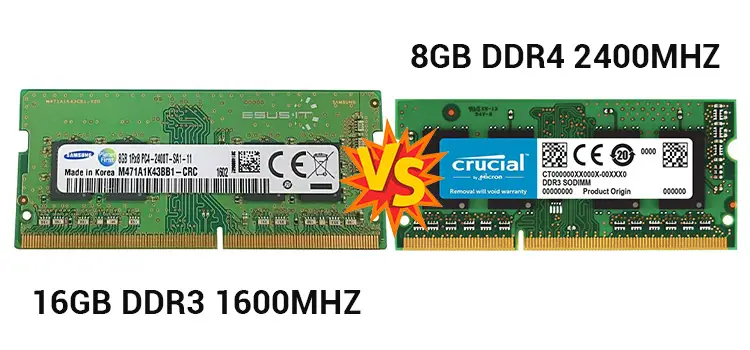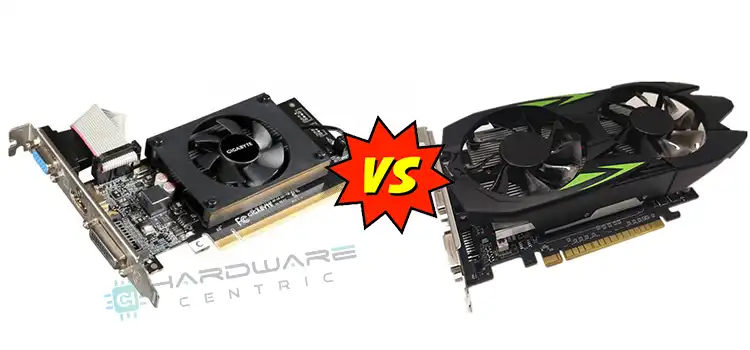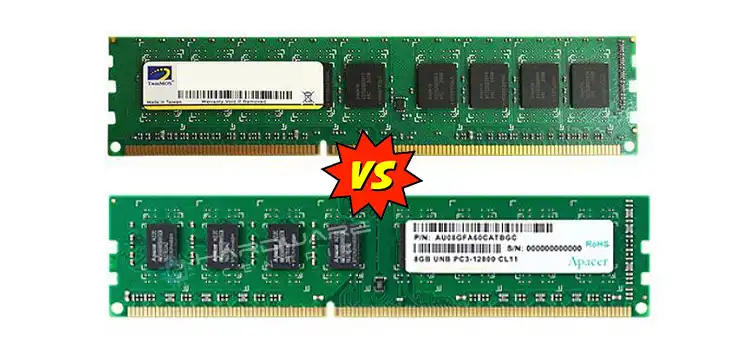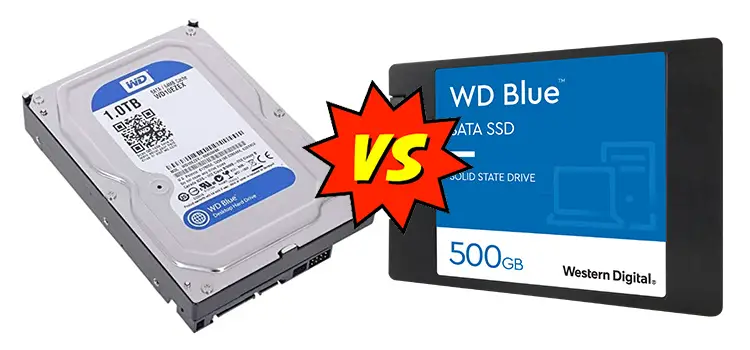16GB ddr3 1600mhz vs 8GB ddr4 2400mhz | Comparison Between Them
DDR3 was swiftly overtaken, out-priced, as well as surpassed by the greater technology that DDR4 was equipped with as time went on. And, even though practically everyone has switched from DDR3 to DDR4, there will still be a few unsolved issues about the subject. Therefore, you may confuse about which one is better – 16GB DDR3 1600Mhz or 8GB DDR4 2400Mhz?
Well, an 8Gb DDR4 2400 MHz is faster than the 16Gb DDR3 1600 Mhz but less in storage capacity. So, if the gaming requirement is a minimum of 16 GB, then you must go for the 16 GB DDR3 1600 MHz RAM. Otherwise, you must choose the 8GB DDR4 2400Mhz RAM.
All of the significant variations between 16Gb DDR3 1600 Mhz and 8Gb DDR4 2400 MHz will be discussed in detail throughout the article. That includes everything from pricing to the delivery time and so on.

16GB ddr3 1600mhz vs 8GB ddr4 2400mhz – A Complete Comparison
Ram is the hardware in a computing device within your computer that stores data in a temporary manner, known as RAM (Random Access Memory). It follows that faster RAM would automatically perform better in terms of information processing because the data contained in the cognitive function can be recorded and accessed at any moment and in any sequence.
Now, let’s have a look at the comparison table below to learn the differences between the 16GB DDR3 1600mhz vs 8GB DDR4 2400mhz.
| 16GB DDR3 1600mhz | 8GB DDR4 2400mhz | |
| Frequency (MHz) | 1600 | 2400 |
| Capacity (GB) | 16 | 8 |
| Release Date | 2007 | 2014 |
| Power Consumption (V) | 1.5 | 1.2 |
| Transfer Rate (GB/s) | 12.8 | 19.2 |
| I/O Bus Clock (MHz) | 800 | 1600 |
| Response Time (ns) | 13.75 | 14.06 |
| DIMM Pins | 240 | 288 |
| SO- DIMM Pins | 204 | 260 |
As before said, DDR3 RAM is just the third generation of what became referred to as SDRAM (Synchronous Dynamic Random Access Memory), but it was still formerly considered to be the best RAM for the money when it came to memory selection. The introduction of DDR4 throughout 2014, on the other hand, has resulted in a significant decline in DDR3 revenues all over the field.
For example, DDR4 RAM offers a slew of exciting new features including enhancements above its predecessor, much just like many other new technologies. It has significantly quicker speeds, larger storage space, and (on the whole) greater quality and reliability.
16GB ddr3 1600mhz vs 8GB ddr4 2400mhz – Which Should Be Considered?
Let’s put looks aside for a while and examine some of the most technical distinctions that exist between 16Gb DDR3 1600mhz versus 8Gb DDR4 2400 Mhz.
1. Pin Connectors
When it comes to 16Gb DDR3 1600mhz versus 8Gb DDR4 2400 Mhz, maybe the most noticeable change is located within their respective pin nodules.
DDR3 launched with a 240 port connector that was intended to work with motherboards from the previous generation of computers. But, when DDR4 was introduced seven years later, this was no longer compatible with the very same 240 connector nodule. It is evident while comparing these two images that the developers chose a bigger pin module of 288 pins, as shown in the comparison.
2. Volume Variations
The height of the two DDRs hasn’t increased in any way – it’s still around 133mm. It’s because the designers had to reduce the spacing between every pin to 0.15mm to handle the increased 48 pins that DDR4 requires.
The height difference of the two components (whenever the condenser is separated) is similarly slightly over an mm in this case. However, with the continuously shifting heatsinks which producers are providing these days, you, as a consumer, don’t notice any significant variations in actual results.
3. Voltage Variations
In terms of voltage ranges both RAMs exhibit a significant degree of variability. The RAM, just like all the other hardware devices, requires a specific amount of electricity to operate properly.
When using it, DDR3 RAM operates at 1.5v, however, DDR4 RAM operates at 1.2v. Taking things on a grander scale, it can be translated roughly like a variance of 15 watts on average.
4. Clock Frequency
Although the reaction times of DDR3, as well as DDR4 RAM, vary markedly, it is important to understand how much rotation speed indicates and how well it impacts the overall performance of your system before diving further into the specifics of this comparison.
DDR3 RAM may operate at a top speed of 2133 megahertz. DDR4 memory runs at 2133MHz and therefore can reach a maximum speed of 4800MHz, resulting in a significantly fast data transfer rate.
5. Refresh the Algorithm
AR (automated refreshing) and SR (synchronous refresh) were two separate algorithms used by older DDR3 RAM (self-refresh).
DDR4 just employs fully automated refresh, which means that it will regularly refresh to ensure that no additional knowledge is needed to be analyzed before it can be used.
DDR4 RAM consumes significantly less power than previous generations, allowing developers to focus entirely on augmented reality, resulting in a significantly more energy-efficient product.
6. Response Time
Response Time is a function to identify how quickly your RAM could further perform the operations. As a result of this, So, it’s important to explain the impact that faster clock rates have on the timings of your RAM module.
If you want to think about it in more technical terms, DDR3 is now working at CL11, which means it requires 13.75 nanoseconds for performing a read operation. When it comes to DDR4, it functions on CL15 and requires 14.06 nanoseconds to complete the same work. The change is approximately 2 percent, which is not a notable change, however, it is noticeable.
7. Memory Storage
Ram is quite simple, therefore DDR4 is a clear winner in this regard. As memory size has grown in importance, particularly when multitasking or playing games, this is one of the primary reasons that DDR4 provides significantly larger capacities.
DDR3 memory has a capacity of 512MB approximately 8GB, but DDR4 memory has a capacity of 4GB higher than or equal to 16GB of Ram. As a result, DDR4 has the capacity to hold twice the amount of data as DDR3.
The advantages of increased RAM capacity are rather significant, and we notice a significant change in performance whenever you increase the RAM’s volume.
8. Cost
DDR4 exceeds DDR3 in every aspect, including performance, storage, quality and design, and thermal management, and it significantly improves DDR3 in just about every other category as well as price.
Even seeking to purchase DDR3 memory these days is much more expensive than purchasing DDR4. Not even to say that in terms of compatibility, you’d needed to have been using ancient Hardware parts.
Frequently Asked Questions
Is 2400mhz RAM Better Than 1600mhz?
MHz indicates the speed of stuff. So, 2400 MHz RAM is much faster than a 1600 MHz RAM. However, which among them is better depends on the CPU that you are using. For example, an i5 9300h CPU supports only 2666 MHz of maximum speed. So, check your CPU specs to identify which speed of RAM is suitable for your computer.
Is It Better to Have 16GB of DDR3 or 8GB of DDR4?
If you are given the option to choose between a 16GB DDR3 and 8GB DDR4 RAM then you need to apply the rule of thumb. As you know the more the storage capacity of a RAM is the better it is. So, don’t think about the version just go for the capacity.
What is the best MHz for 16GB RAM?
The best MHz for a 16GB RAM is 3200 to 3600 MHz frequency. However, it depends on how much frequency your CPU can support. We’d recommend to use 2400 MHz frequency with a 16GB RAM which is plenty for most users.
Is 16GB DDR3 Good for Gaming?
Yes, 16 GB is the recommended storage capacity of RAM for playing most games. Although, DDR3 is an older version of RAM stick, it is still worthy of running applications in the background without affecting gameplay.
Is 8GB DDR4 RAM Good for Gaming?
No matter you are using DDR3 or DDR4, you need the required amount of storage capacity to play a game. As modern games required higher than 16 GB RAM, you can play many games on your PC with the 8GB DDR4 RAM. However, you can play some games that is required only 8 GB RAM.
Conclusion
In today’s marketplace, DDR4 is unquestionably a worthwhile investment. If I had written this post 5 years earlier, you might have come to a different conclusion. The good news is that DDR4 has virtually eliminated the need for DDR3. If your computer equipment is still using last-generation technology, I strongly advise that you upgrade your overall system. The availability of low-cost components means that you could assemble a computer for less than $300.
Subscribe to our newsletter
& plug into
the world of PC Hardwares
![[4 Fixes] SMART Hard Disk Error NVME SSD 313](https://www.hardwarecentric.com/wp-content/uploads/2023/01/Smart-Hard-Disk-Error-NVME-SSD-313.webp)

![[Fix] 3000MHZ RAM Running at 2133MHZ (100% Working)](https://www.hardwarecentric.com/wp-content/uploads/2022/10/3000MHZ-Ram-Running-at-2133.jpg)



